Sánchez-Sampedro L, Gómez CE, Mejías-Pérez E, Pérez-Jiménez E, Oliveros JC, Esteban M.
 Replication competent poxvirus vectors with an attenuation phenotype and with high immunogenic capacity of the foreign expressed antigen are being pursuit as novel vaccine vectors against different pathogens. In this investigation we have examined the replication and immunogenic characteristics of two vaccinia virus (VACV) mutants M65 and M101.
Replication competent poxvirus vectors with an attenuation phenotype and with high immunogenic capacity of the foreign expressed antigen are being pursuit as novel vaccine vectors against different pathogens. In this investigation we have examined the replication and immunogenic characteristics of two vaccinia virus (VACV) mutants M65 and M101.
These mutants were generated after 65 and 101 serial passages of persistently infected Friend erythroleukemia cells (FEL). In cultured cells of different origins the mutants are replication competent and have growth kinetics similar or slightly reduced in comparison with the parental Western Reserve (WR) virus strain. In normal and immune suppressed infected mice the mutants showed different attenuation levels, and pathogenicity in comparison with WR and MVA strains. Wide genome analysis after deep sequencing revealed selected genomic deletions and mutations in a number of viral open-reading frames (ORFs). Mice immunized in DNA prime/Mutant boost regime with viral vectors expressing the LACK antigen of Leismania infantum resulted in protection or delay in the onset of cutaneus leishmaniasis. Protection was similar to that triggered by MVA-LACK. In immunized mice, both polyfunctional CD4+ and CD8+ T cells with an effector memory phenotype were activated by the two mutants, but DNA-LACK/M65-LACK protocol preferentially induced CD4+ while DNA-LACK/M101-LACK preferentially induced CD8+ T cell responses.
Altogether our findings showed the adaptive changes of the WR genome during long-term virus-host cell interaction and how replication competency of M65 and M101 mutants confers distinct biological properties and immunogenicity in mice, as compared to the MVA strain. These mutants could have applicability for understanding VACV biology and as potential vaccine vectors against pathogens and tumors.
J Virol. 2013 Jul;87(13):7282-300
Gómez CE, Perdiguero B, Cepeda MV, Mingorance L, García-Arriaza J, Vandermeeren A, Sorzano CO, Esteban M.
 A major goal in the control of hepatitis C infection is the development of a vaccine. Here, we have developed a novel HCV vaccine candidate based on the highly attenuated poxvirus vector MVA (referred as MVA-HCV) expressing the near full-length (7.9 kbp) HCV sequence, with the aim to target almost all of the T and B cell determinants described for HCV.
A major goal in the control of hepatitis C infection is the development of a vaccine. Here, we have developed a novel HCV vaccine candidate based on the highly attenuated poxvirus vector MVA (referred as MVA-HCV) expressing the near full-length (7.9 kbp) HCV sequence, with the aim to target almost all of the T and B cell determinants described for HCV.
In infected cells, MVA-HCV produces a polyprotein that is subsequently processed into the structural and nonstructural HCV proteins, triggering the cytoplasmic accumulation of dense membrane aggregates. In both C57BL/6 and transgenic HLA-A2 vaccinated mice, MVA-HCV induced high, broad, polyfunctional and long-lasting HCV-specific T cell immune responses. The vaccine-induced T cell response was mainly mediated by CD8 T cells; however, although lower in magnitude, the CD4+ T cells were highly polyfunctional. In homologous protocol (MVA-HCV/MVA-HCV) the main CD8+ T cell target was p7+NS2, whereas in heterologous combination (DNA-HCV/MVA-HCV) the main target was NS3. Antigenic responses were also detected against other HCV proteins (Core, E1-E2, NS4) but the magnitude of the responses was dependent of the protocol used. The majority of the HCV-induced CD8+ T cells were triple or quadruple-cytokine producers. The MVA-HCV vaccine induced memory CD8+ T cell responses with an effector memory (TEM) phenotype.
Overall, our data showed that MVA-HCV induced broad, highly polyfunctional and durable T cell responses of a magnitude and quality that might be associated with protective immunity and open the path for future considerations of MVA-HCV as prophylactic and/or therapeutic vaccine candidate against HCV.
Un estudio internacional en el que ha participado la investigadora del CNB Cristina Risco ha publicado en la revista PNAS la estructura de la ribonucleoproteína del virus Bunyamwera, modelo de estudio de los integrantes de la familia Bunyaviridae, a la que también pertenecen los virus que provocan la fiebre hemorrágica de Congo y Crimea y la fiebre del valle del Rift.
"Uno de los principales resultados de esta investigación es que la flexibilidad de la nucleoproteína que envuelve el ARN de Bunyamwera facilita el empaquetamiento de su material genético en las partículas virales y su replicación una vez fuera del virus. La estructura atómica muestra que el plegamiento de la nucleoproteína es, además, diferente al observado en las demás nucleoproteínas de virus conocidas”, explica Risco.
Este estudio muestra que, a pesar de su flexibilidad, el complejo que recubre el material genético lo protege completamente del ataque de las nucleasas, las enzimas que rompen las moléculas de ARN.
Los resultados de este estudio ayudan a entender mejor el mecanismo molecular mediante el que se ensamblan las ribonucleoproteínas virales. "Este conocimiento permitirá avanzar en el desarrollo de compuestos para atacar a estos complejos macromoleculares que son esenciales para la supervivencia de los virus ARN", añade desde el mismo laboratorio del Centro Nacional de Biotecnología del CSIC la investigadora Isabel Fernández de Castro.
Los hallazgos logrados por este estudio, liderado por investigadores chinos, ha sido posible mediante el uso de cristalografía de rayos X y microscopía electrónica. Como se aprecia en la imagen, el complejo formado por el monómero de la proteína viral NP y el ARN, la flexibilidad de este complejo respecto a los adyacentes es el elemento básico que dirige la oligomerización y ensamblaje de las ribonucleoproteínas lineales y flexibles del virus Bunyamwera.
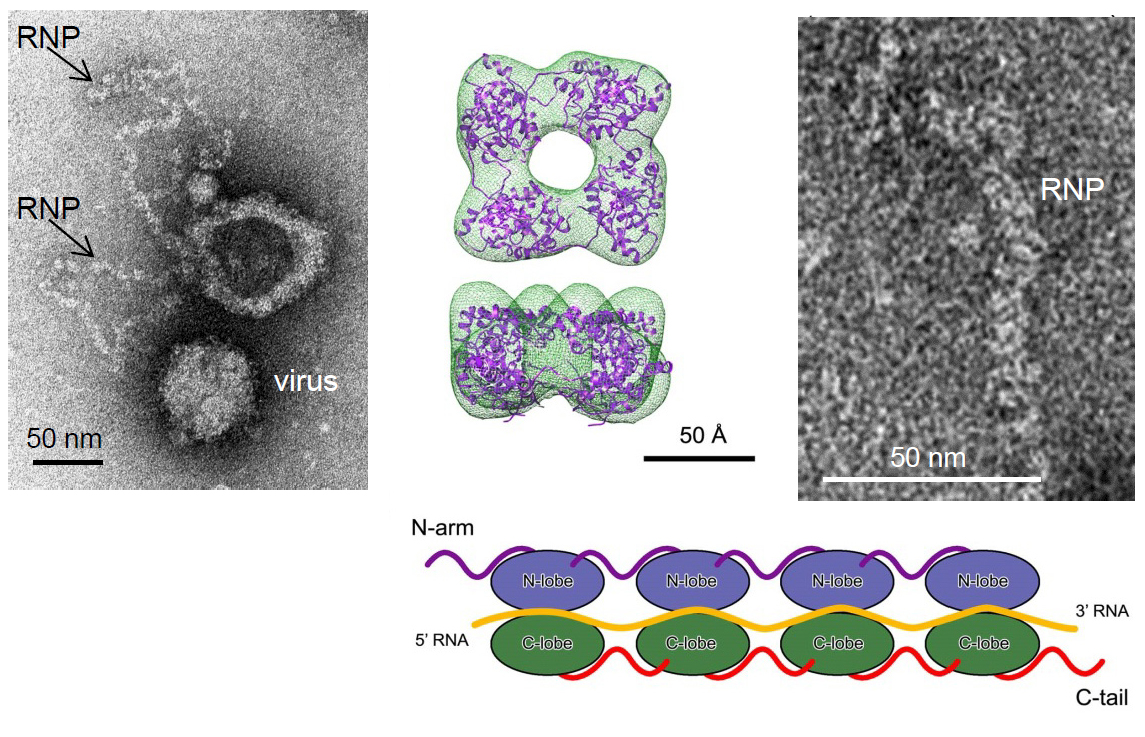
- Li B, Wang Q, Pan X, Fernández de Castro I, Sun Y, Guo Y, Tao X, Risco C, Su SF, Lou Z. Bunyamwera virus possesses a distinct nucleocapsid protein to facilitate genome encapsidation. PNAS April 8, 2013 doi: 10.1073/pnas.1222552110.
Li B, Wang Q, Pan X, Fernández de Castro I, Sun Y, Guo Y, Tao X, Risco C, Su SF, Lou Z.
 Bunyamwera virus (BUNV), which belongs to the genus Orthobunyavirus, is the prototypical virus of the Bunyaviridae family. Similar to other negative-sense single-stranded RNA viruses, bunyaviruses possess a nucleocapsid protein (NP) to facilitate genomic RNA encapsidation and virus replication.
Bunyamwera virus (BUNV), which belongs to the genus Orthobunyavirus, is the prototypical virus of the Bunyaviridae family. Similar to other negative-sense single-stranded RNA viruses, bunyaviruses possess a nucleocapsid protein (NP) to facilitate genomic RNA encapsidation and virus replication.
The structures of two NPs of members of different genera within the Bunyaviridae family have been reported. However, their structures, RNA-binding features, and functions beyond RNA binding significantly differ from one another. Here, we report the crystal structure of the BUNV NP–RNA complex. The polypeptide of the BUNV NP was found to possess a distinct fold among viral NPs. An N-terminal arm and a C-terminal tail were found to interact with neighboring NP protomers to form a tetrameric ring-shaped organization. Each protomer bound a 10-nt RNA molecule, which was acquired from the expression host, in the positively charged crevice between the N and C lobes. Inhomogeneous oligomerization was observed for the recombinant BUNV NP–RNA complex, which was similar to the Rift Valley fever virus NP–RNA complex.
This result suggested that the flexibility of one NP protomer with adjacent protomers underlies the BUNV ribonucleoprotein complex (RNP) formation. Electron microscopy revealed that the monomer-sized NP–RNA complex was the building block of the natural BUNV RNP. Combined with previous results indicating that mutagenesis of the interprotomer or protein–RNA interface affects BUNV replication, our structure provides a great potential for understanding the mechanism underlying negative-sense single-stranded RNA RNP formation and enables the development of antiviral therapies targeting BUNV RNP formation.
Castón JR, Luque D, Gómez-Blanco J, Ghabrial SA.
 Chrysoviruses are double-stranded RNA viruses with a multipartite genome. Structure of two fungal chrysoviruses, Penicillium chrysogenum virus and Cryphonectria nitschkei chrysovirus 1, has been determined by three-dimensional cryo-electron microscopy analysis and in hydrodynamic studies.
Chrysoviruses are double-stranded RNA viruses with a multipartite genome. Structure of two fungal chrysoviruses, Penicillium chrysogenum virus and Cryphonectria nitschkei chrysovirus 1, has been determined by three-dimensional cryo-electron microscopy analysis and in hydrodynamic studies.
The capsids of both viruses are based on a T=1 lattice containing 60 subunits, remain structurally undisturbed throughout the viral cycle, and participate in genome metabolism. The capsid protein is formed by a repeated α-helical core, indicative of gene duplication.
Whereas the chrysovirus capsid protein has two motifs with the same fold, most dsRNA virus capsid subunits consist of dimers of a single protein with similar folds. The arrangement of the chrysovirus α-helical core is conserved in the totivirus L-A capsid protein, suggesting a shared basic fold. The encapsidated genome is organized in concentric shells; whereas inner dsRNA shells are diffuse, the outermost layer is organized into a dodecahedral cage beneath the protein capsid. This genome ordering could constitute a framework for dsRNA transcription in the capsid interior and/or have a structural role for capsid stability.
Philos Trans R Soc Lond B Biol Sci. 2013 Mar 11;368(1616):20120377
Nikel PI, Pérez-Pantoja D, de Lorenzo V.
 Chlorinated pollutants are hardly biodegradable under oxic conditions, but they can often be metabolized by anaerobic bacteria through organohalide respiration reactions.
Chlorinated pollutants are hardly biodegradable under oxic conditions, but they can often be metabolized by anaerobic bacteria through organohalide respiration reactions.
In an attempt to identify bottlenecks limiting aerobic catabolism of 1,3-dichloroprop-1-ene (1,3-DCP; a widely used organohalide) in Pseudomonas pavonaceae, the possible physiological restrictions for this process were surveyed. Flow cytometry and a bioluminescence reporter of metabolic state revealed that cells treated with 1,3-DCP experienced an intense stress that could be traced to the endogenous production of reactive oxygen species (ROS) during the metabolism of the compound. Cells exposed to 1,3-DCP also manifested increased levels of d-glucose-6-P 1-dehydrogenase activity (G6PDH, an enzyme key to the synthesis of reduced NADPH), observed under both glycolytic and gluconeogenic growth regimes. The increase in G6PDH activity, as well as cellular hydroperoxide levels, correlated with the generation of ROS. Additionally, the high G6PDH activity was paralleled by the accumulation of d-glucose-6-P, suggesting a metabolic flux shift that favours the production of NADPH. Thus, G6PDH and its cognate substrate seem to play an important role in P. pavonaceae under redox stress caused by 1,3-DCP, probably by increasing the rate of NADPH turnover.
The data suggest that oxidative stress associated with the biodegradation of 1,3-DCP reflects a significant barrier for the evolution of aerobic pathways for chlorinated compounds, thereby allowing for the emergence of anaerobic counterparts.
In this paper we have addressed the problem of analysing Next Generation Sequencing samples with an expected large biodiversity content. We analysed several well-known 16S rRNA datasets from experimental samples, including both large and short sequences, in numbers of tens of thousands, in addition to carefully crafted synthetic datasets containing more than 7000 OTUs.
From this data analysis several patterns were identified and used to develop new guidelines for experimentation in conditions of high biodiversity. We analysed the suitability of different clustering packages for these type of situations, the problem of even sampling, the relative effectiveness of Chao1 and ACE estimators as well as their effect on sampling size for a variety of population distributions. As regards practical analysis procedures, we advocated an approach that retains as much high-quality experimental data as possible. By carefully applying selection rules combining the taxonomic assignment with clustering strategies, we derived a set of recommendations for ultra-sequencing data analysis at high biodiversity levels.
Talanta. doi: 10.1016/j.talanta.2013.02.018
Vega B, Calle A, Sánchez A, Lechuga LM, Ortiz AM, Armelles G, Rodríguez-Frade JM, Mellado M.
 Surface plasmon resonance (SPR)-based biosensors are established tools for measuring biomolecular interactions between unlabeled analytes in real time, and are thus an ideal method to evaluate G protein-coupled receptor (GPCR) binding interactions. Using as a vehicle lentiviral particles bearing the chemokine receptor CXCR4 in its native plasma membrane context, SPR analysis can be performed using the particles as specific receptors to monitor the CXCR4 interaction with its ligand, CXCL12. The method shows linear correlation in the 5–40 nM range, with low intra- and inter-assay variation, a relative standard deviation <10%, chip-to-chip variation <12%, with stability of the sensor response for more than 150 measurements in the same chip over a four-week period.
Surface plasmon resonance (SPR)-based biosensors are established tools for measuring biomolecular interactions between unlabeled analytes in real time, and are thus an ideal method to evaluate G protein-coupled receptor (GPCR) binding interactions. Using as a vehicle lentiviral particles bearing the chemokine receptor CXCR4 in its native plasma membrane context, SPR analysis can be performed using the particles as specific receptors to monitor the CXCR4 interaction with its ligand, CXCL12. The method shows linear correlation in the 5–40 nM range, with low intra- and inter-assay variation, a relative standard deviation <10%, chip-to-chip variation <12%, with stability of the sensor response for more than 150 measurements in the same chip over a four-week period.
Our objective was to develop a method for rapid detection and quantification of analytes such as CXCL12 in biological samples, with no need for pretreatment. As a proof of concept, we tested for CXCL12 in urine samples from rheumatoid arthritis patients, who have elevated levels of this chemokine in plasma and synovial fluid. The biosensor method allowed sensitive, reproducible CXCL12 detection in the physiological range, suggesting its value for the diagnosis of autoimmune disorders.
Plant Physiol. 2013 Feb;161(2):617-27
Vellosillo T, Aguilera V, Marcos R, Bartsch M, Vicente J, Cascón T, Hamberg M, Castresana C.
 9-Lipoxygenases (9-LOXs) initiate fatty acid oxygenation, resulting in the formation of oxylipins activating plant defense against hemibiotrophic pathogenic bacteria. Previous studies using nonresponding to oxylipins (noxy), a series of Arabidopsis (Arabidopsis thaliana) mutants insensitive to the 9-LOX product 9-hydroxy-10,12,15-octadecatrienoic acid (9-HOT), have demonstrated the importance of cell wall modifications as a component of 9-LOX-induced defense.
9-Lipoxygenases (9-LOXs) initiate fatty acid oxygenation, resulting in the formation of oxylipins activating plant defense against hemibiotrophic pathogenic bacteria. Previous studies using nonresponding to oxylipins (noxy), a series of Arabidopsis (Arabidopsis thaliana) mutants insensitive to the 9-LOX product 9-hydroxy-10,12,15-octadecatrienoic acid (9-HOT), have demonstrated the importance of cell wall modifications as a component of 9-LOX-induced defense.
Here, we show that a majority (71%) of 41 studied noxy mutants have an added insensitivity to isoxaben, an herbicide inhibiting cellulose synthesis and altering the cell wall. The specific mutants noxy2, noxy15, and noxy38, insensitive to both 9-HOT and isoxaben, displayed enhanced susceptibility to Pseudomonas syringae DC3000 as well as reduced activation of salicylic acid-responding genes. Map-based cloning identified the mutation in noxy2 as At5g11630 encoding an uncharacterized mitochondrial protein, designated NOXY2.
Moreover, noxy15 and noxy38 were mapped at the DYNAMIN RELATED PROTEIN3A and FRIENDLY MITOCHONDRIA loci, respectively. Fluorescence microscopy and molecular analyses revealed that the three noxy mutants characterized exhibit mitochondrial dysfunction and that 9-HOT added to wild-type Arabidopsis causes mitochondrial aggregation and loss of mitochondrial membrane potential. The results suggest that the defensive responses and cell wall modifications caused by 9-HOT are under mitochondrial retrograde control and that mitochondria play a fundamental role in innate immunity signaling.
Con motivo del vigésimo aniversario del Centro Nacional de Biotecnología del CSIC (CNB), la semana pasada, la Reina Doña Sofía visitó sus laboratorios en compañía de la directora del CNB, Carmen Castresana, y de su antecesor en el cargo, José María Valpuesta.
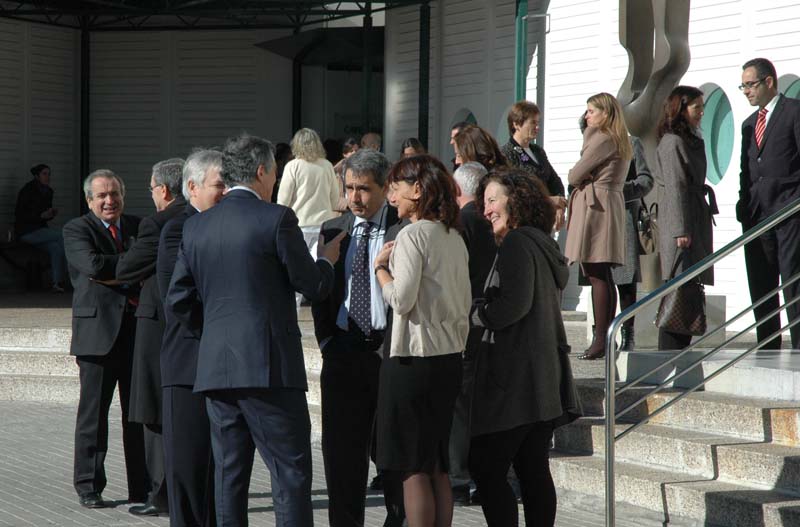 Doña Sofía, acompañada, entre otras autoridades, por la ministra de Fomento, Ana Pastor, el presidente del CSIC, Emilio Lora-Tamayo, y el rector de la Universidad Autónoma de Madrid, José Mª Sanz Martínez, mantuvo una reunión de trabajo con el director saliente, José María Valpuesta; su sucesora, Carmen Castresana; tres investigadores que también ocuparon este puesto (Mariano Esteban, José Ramón Naranjo y José López Carrascosa); y el científico del CNB Carlos Martínez-Alonso, quien fuera en su momento presidente del CSIC y anterior Secretario de Estado de Investigación.
Doña Sofía, acompañada, entre otras autoridades, por la ministra de Fomento, Ana Pastor, el presidente del CSIC, Emilio Lora-Tamayo, y el rector de la Universidad Autónoma de Madrid, José Mª Sanz Martínez, mantuvo una reunión de trabajo con el director saliente, José María Valpuesta; su sucesora, Carmen Castresana; tres investigadores que también ocuparon este puesto (Mariano Esteban, José Ramón Naranjo y José López Carrascosa); y el científico del CNB Carlos Martínez-Alonso, quien fuera en su momento presidente del CSIC y anterior Secretario de Estado de Investigación.
Durante la reunión, Naranjo expuso los pormenores de su proyecto de investigación sobre el alzheimer que se financia, en parte, gracias a la Fundación Reina Sofía. Mariano Esteban tuvo ocasión asimismo de exponer a la Reina los avances obtenidos en los ensayos clínicos de su vacuna contra el sida y sus experimentos con vacunas contra la malaria, la leishmaniasis y la gripe. López Carrascosa, por su parte, explicó la marcha de sus trabajos sobre la estructura de los virus. Finalmente Martínez-Alonso habló de sus estudios sobre el papel de las células madre en el desarrollo y la metástasis del cáncer.
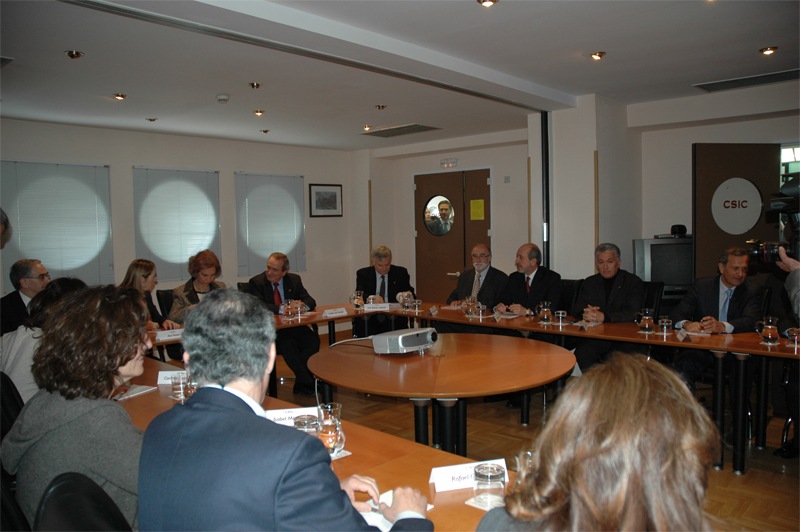 A continuación realizaron un recorrido por las instalaciones del CNB, entre las que destacan el servicio de microscopía confocal, el microscopio electrónico, el citómetro de flujo, el laboratorio de pinzas ópticas y las instalaciones de cultivo de plantas del CNB.
A continuación realizaron un recorrido por las instalaciones del CNB, entre las que destacan el servicio de microscopía confocal, el microscopio electrónico, el citómetro de flujo, el laboratorio de pinzas ópticas y las instalaciones de cultivo de plantas del CNB.
La visita comenzó en el laboratorio de microscopía confocal. En el, Sylvia Gutiérrez Erlandsson mostró las imágenes digitales que se obtienen actualmente de las células gracias al empleo de láseres. Con esta tecnología y el uso de marcadores fluorescentes en las muestras, se pueden localizar los distintos componentes de las células.
Durante la visita al microscopio electrónico, Jaime Martín-Benito le pudo explicar cómo funcionan este tipo de microscopios y le estuvo enseñando algunos ejemplos como su último trabajo publicado en la revista Science en el que describen la estructura de las proteínas responsables de la replicación y expresión del material genético del virus de la gripe A.
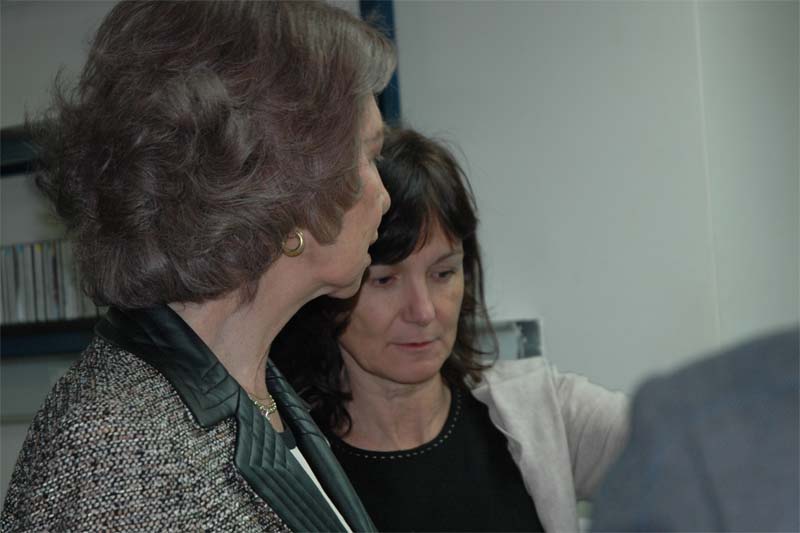 A continuación, María del Carmen Moreno-Ortiz explicó a Doña Sofía en qué consiste la técnica de la citometría de flujo. Entre los ejemplos interesantes de cómo se pueden analizar las distintas poblaciones celulares de una muestra, Moreno tuvo la oportunidad de mostrar cómo se pueden separar las células tumorales de las células normales.
A continuación, María del Carmen Moreno-Ortiz explicó a Doña Sofía en qué consiste la técnica de la citometría de flujo. Entre los ejemplos interesantes de cómo se pueden analizar las distintas poblaciones celulares de una muestra, Moreno tuvo la oportunidad de mostrar cómo se pueden separar las células tumorales de las células normales.
Su Majestad tuvo la oportunidad de conocer de mano de Elías Herrero y Borja Ibarra la llamada técnica de pinzas ópticas. Esta revolucionaria técnica permite a los investigadores atrapar cualquier molécula individualmente (desde una proteína al ADN) y medir los cambios que sufre mientras ejerce su función.
Finalmente, en el invernadero del CNB, Carlos Alonso y Salomé Prat tuvieron la oportunidad de mostrar brevemente las plantas que se cultivan y explicar las últimas investigaciones llevadas a cabo por los científicos del Departamento de Genética Molecular de Plantas.
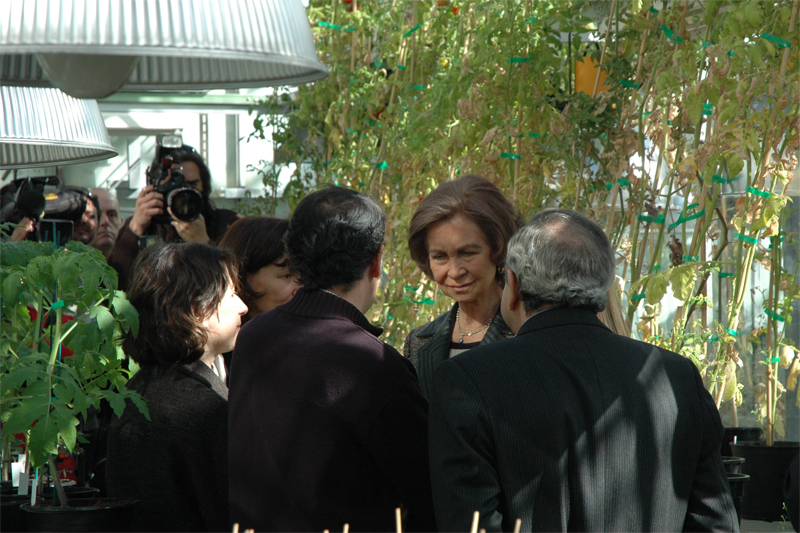
COOKIES POLICY
A cookie is a text file that is stored on your computer or mobile device via a web server and only that server will be able to retrieve or read the contents of the cookie and allow the Web site remember browser preferences and navigate efficiently. Cookies make the interaction between the user and the website faster and easier.
General information
This Website uses cookies. Cookies are small text files generated by the web pages you visit, which contain the session data that can be useful later in the website. In this way this Web remembers information about your visit, which can facilitate your next visit and make the website more useful.
How do cookies?
Cookies can only store text, usually always anonymous and encrypted. No personal information is ever stored in a cookie, or can be associated with identified or identifiable person.
The data allow this website to keep your information between the pages, and also to discuss how to interact with the website. Cookies are safe because they can only store information that is put there by the browser, which is information the user entered in the browser or included in the page request. You can not run the code and can not be used to access your computer. If a website encrypts cookie data, only the website can read the information.
What types of cookies used?
The cookies used by this website can be distinguished by the following criteria:
1. Types of cookies as the entity that manages:
Depending on who the entity operating the computer or domain where cookies are sent and treat the data obtained, we can distinguish:
- Own cookies: are those that are sent to the user's terminal equipment from a computer or domain managed by the editor itself and from which provides the service requested by the user.
- Third party cookies: these are those that are sent to the user's terminal equipment from a machine or domain that is not managed by the publisher, but by another entity data is obtained through cookies.
In the event that the cookies are installed from a computer or domain managed by the editor itself but the information collected by these is managed by a third party can not be considered as party cookies.
2. Types of cookies as the length of time that remain active:
Depending on the length of time that remain active in the terminal equipment can be distinguished:
- Session cookies: cookies are a type designed to collect and store data while the user accesses a web page. Are usually used to store information that only worth preserving for the service requested by the user at any one time (eg a list of products purchased).
- Persistent cookies: cookies are a type of data which are stored in the terminal and can be accessed and treated for a period defined by the head of the cookie, and can range from a few minutes to several years.
3. Cookies types according to their purpose:
Depending on the purpose for which the data are processed through cookies, we can distinguish between:
- Technical cookies: these are those that allow the user to navigate through a web page or application platform and the use of different options or services it exist as, for example, control traffic and data communication, identify the session, access to restricted access parts, remember the elements of an order, make the buying process an order, make an application for registration or participation in an event, use security features while browsing store content for dissemination videos or sound or share content via social networks.
- Customization cookies: these are those that allow the user to access the service with some general characteristics based on a predefined set of criteria in the user terminal would eg language, the type of browser through which you access the service, the locale from which you access the service, etc.
- Analysis cookies: they are those that allow the responsible for them, monitoring and analyzing the behavior of users of the web sites that are linked. The information gathered through such cookies are used in measuring the activity of web sites, application or platform and for the profiling of user navigation of such sites, applications and platforms, in order to make improvements function data analysis how users use the service.
Management tool cookies
This Website uses Google Analytics.
Google Analytics is a free tool from Google that primarily allows website owners know how users interact with your website. Also, enable cookies in the domain of the site in which you are and uses a set of cookies called "__utma" and "__utmz" to collect information anonymously and reporting of website trends without identifying individual users..
For statistics of use of this website use cookies in order to know the level of recurrence of our visitors and more interesting content. This way we can concentrate our efforts on improving the most visited areas and make the user more easily find what they are looking for. On this site you can use the information from your visit for statistical evaluations and calculations anonymous data and to ensure the continuity of service or to make improvements to their websites. For more details, see the link below privacy policy [http://www.google.com/intl/en/policies/privacy/]
How to manage cookies on your computer: disabling and deleting cookies
All Internet browsers allow you to limit the behavior of a cookie or disable cookies within settings or browser settings. The steps for doing so are different for each browser, you can find instructions in the help menu of your browser.
If you decline the use of cookies, since it is possible thanks to the preferences menu of your browser or settings, reject, this website will continue to function properly without the use of the same.
Can you allow, block or delete cookies installed on your computer by setting your browser options installed on your computer:
- For more information about Internet Explorer click here.
- For more information on Chrome click here.
- For more information about Safari click here.
- For more information about Firefox click here.
Through your browser, you can also view the cookies that are on your computer, and delete them as you see fit. Cookies are text files, you can open and read the contents. The data within them is almost always encrypted with a numeric key corresponding to an Internet session so often has no meaning beyond the website who wrote it.
Informed consent
The use of this website on the other hand, implies that you paid your specific consent to the use of cookies, on the terms and conditions provided in this Cookies Policy, without prejudice to the measures of deactivation and removal of cookies that you can take, and mentioned in the previous section.





